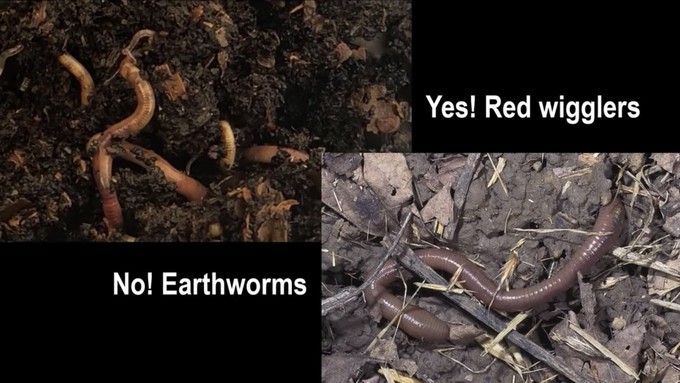
Sacramento video program an award winner

Tips on worm composting -- including the right type of worms -- are in one of the Sacramento County master gardeners' YouTube videos. Screen grab from "Making a Worm Bin"
Darkness has descended on the garden. Even on a clear day now, 4:30 p.m. is dark enough to remind gardeners to put away their tools soon and head indoors.
But the short gardening days of November and December still can be put to use: A wealth of gardening videos awaits. And preferably local ones, filmed for the Sacramento-area climate and gardening culture.
The UCCE master gardeners of Sacramento County have an active YouTube channel, with short, to-the-point videos. And the video program now is an award winner, receiving third place in this year's statewide Search for Excellence competition at the UCCE Master Gardeners Conference last month. The video submitted for the competition will debut at noon Nov. 16 on YouTube. Watch a presentation that day here on Facebook live.
In the meantime, here are suggestions for viewing this time of year:
-- Making a Worm Bin with master gardener Patty Peterson. Start a bin now and you could have rich worm castings to use in the garden next spring. A companion video shows how to harvest the castings.
-- Sharpening Hand Pruners, with master gardener Bill Black. Gardeners use their pruners all year, and it's easy for them to grow dull. This is a clear, concise instructional video that you'll come back to annually.
-- Gardening Year 'Round with Farmer Fred Hoffman. This 18-minute video was Fred's keynote talk for the 2021 all-online Harvest Day celebration. Though filmed for August viewing, it includes pertinent information for November and December on planting radishes, carrots and kale. He also discusses raised beds and cold frames for protecting cool-season vegetables, and advocates cover crops for gardens that are not being planted in winter. "At least feed your soil," indeed.
The statewide Master Gardener Program also has plenty of videos, available here. Happy viewing!
Comments
0 comments have been posted.Sacramento Digs Gardening to your inbox.
Food in My Back Yard Series
May 6: Maintain soil moisture with mulch for garden success
April 29: What's (already) wrong with my tomato plants?
April 22: Should you stock up on fertilizer? (Yes!)
April 15: Grow culinary herbs in containers
April 8: When to plant summer vegetables
April 1: Don't be fooled by these garden myths
March 25: Fertilizer tips: How to 'feed' your vegetables for healthy growth
March 18: Time to give vegetable seedlings some more space
March 11: Ways to win the fight against weeds
March 4: Potatoes from the garden
Feb. 25: Plant a fruit tree now -- for later
Feb. 18: How to squeeze more food into less space
Feb. 11: When to plant? Consider staggering your transplants
Feb. 4: Starting in seed starting
Sites We Like
Garden Checklist for week of May 11
Make the most of the lower temperatures early in the week. We’ll be back in the 80s by Thursday.
* Plant, plant, plant! It’s prime planting season in the Sacramento area. Time to set out those tomato transplants along with peppers and eggplants. Pinch off any flowers on new transplants to make them concentrate on establishing roots instead of setting premature fruit.
* Direct-seed melons, cucumbers, summer squash, corn, radishes, pumpkins and annual herbs such as basil.
* Harvest cabbage, lettuce, peas and green onions.
* In the flower garden, direct-seed sunflowers, cosmos, salvia, zinnias, marigolds, celosia and asters. (You also can transplant seedlings for many of the same flowers.)
* Plant dahlia tubers.
* Transplant petunias, marigolds and perennial flowers such as astilbe, columbine, coneflowers, coreopsis, dahlias, rudbeckia and verbena.
* Keep an eye out for slugs, snails, earwigs and aphids that want to dine on tender new growth.
* Feed summer bloomers with a balanced fertilizer.
* For continued bloom, cut off spent flowers on roses as well as other flowering plants.
* Add mulch to the garden to maintain moisture. Mulch also cuts down on weeds. But don’t let it mound around the stems or trunks of trees or shrubs. Leave about a 6-inch-to-1-foot circle to avoid crown rot or other problems.
* Remember to weed! Pull those nasties before they set seed.
* Water early in the day and keep seedlings evenly moist.